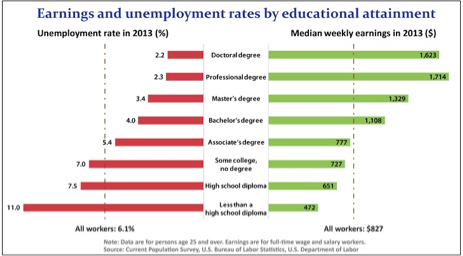You already know that going to college is important, right? If not, here’s a chart from the U.S. Bureau of Labor Statistics that shows pretty clearly what a bachelor’s degree is worth. College grads earn more money and are less likely to be unemployed than other Americans. It’s that simple.

But not everyone has to go to college in the same way.
Right now there’s a massive shift going on in America’s college system. People are angry that college costs so much, focuses on the wrong things, and doesn’t always help students prepare for life after graduation.
If you want to get some background on this debate, there’s a great CNN documentary that recently aired. Watch Ivory Tower here.
Meanwhile, here are some of the new college options that are becoming more popular every year.
Online College Programs
PROS: Online college programs are definitely making college more accessible for huge numbers of Americans. In the past, getting to a physical campus was a big problem for students in rural areas, students with unpredictable working hours, or students who couldn’t afford childcare.
CONS: Making progress in an online college program can still take just as long as a college degree earned on campus (up to four years for all the classes involved in a bachelor’s degree). Also, many online college programs do not include live instructors. So students are missing a key source of support. And if you choose a school that offers self-paced degrees, you may not have the focus or discipline to ever get across the finish line.
MOOCs
PROS: MOOC stands for “massive open online course.” MOOCs have become very popular in recent years because people are realizing how inefficient the current college system is. For example, does it really make sense to have 500 different instructors teaching the same class in 500 different colleges— especially if some of these instructors aren’t very good at teaching?
Thanks to the Internet, there’s no reason why we can’t all attend the very best instructor’s class (e.g. a Stanford professor’s class), online. That’s what a MOOC allows people to do. Bonus: they are usually free courses.
CONS: MOOCs are still pretty new, and their developers don’t have a solid plan for helping students earn credit. Right now you can’t complete a series of MOOCs and say that you have earned a degree. There aren’t enough controls to ensure you did the work yourself. And even though you might be a hardworking student, employers can’t trust that these courses mean anything—at least not right now.
Accelerated College Programs (with Credit-by-Exam)
PROS: Accelerated college programs that use a credit-by-exam model are much faster than other college options. They let students “test out” of required courses. Accelerated college programs also help students prove knowledge of material they have already learned—either on the job or during past college experiences. Here’s a bit more info on accelerated degrees that use credit-by-exam.
CONS: Not all colleges have flexible transfer policies. Some might only accept three or four courses’ worth of outside credits. They want students to complete more coursework at their school (and pay the full tuition for it.) Students have to find a college that fits with their degree plans and will accept the majority of their standardized exam credits.
Achieve Test Prep
Here at ATP, we’re not an online college. And we don’t offer any degrees. Here’s our role:
We help students succeed with accelerated college programs. We prepare them for standardized exams, and we help them find a college that will accept their credits. In the process, students save time, money, and wasted effort from previous studies. If you want to know more about how it works, we’d love to hear from you.
Contact Achieve Test Prep today for more information or visit http://www.achievetestprep.com/bloggd.





